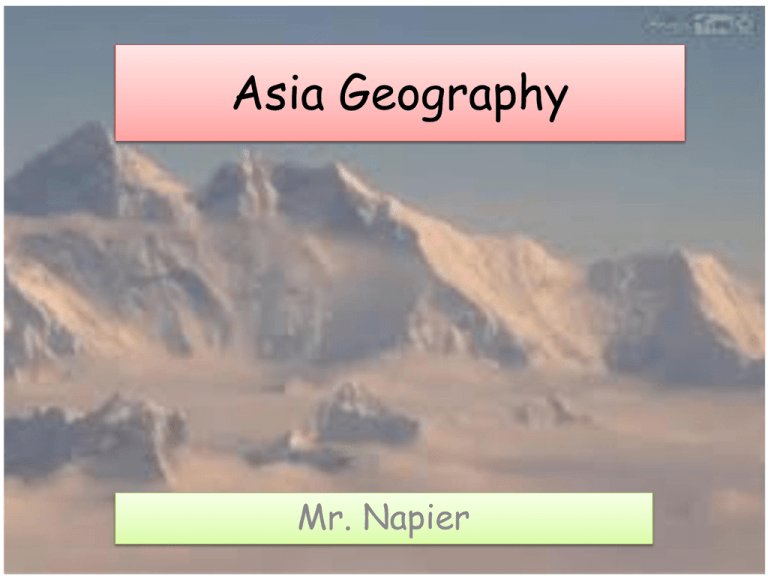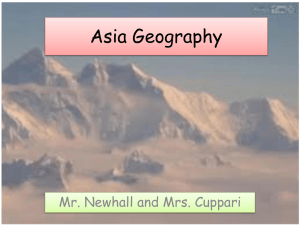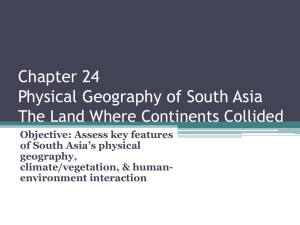Asia Geography
advertisement

Asia Geography Mr. Napier Standards for Southern and Eastern Asia • SS7G9 The student will locate selected features in Southern and Eastern Asia a. Locate on a world and regional political-physical map: Ganges River, Huang He (Yellow River), Indus River, Mekong River, Chang Jiang (Yangtze River), Bay of Bengal, Indian Ocean, Sea of Japan, South China Sea, Yellow Sea, Gobi Desert, Taklimakan Desert, Himalayan Mountains, and Korean Peninsula b. Locate on a world and regional political-physical map the countries of China, India, Indonesia, Japan, North Korea, South Korea, and Vietnam Standards con’t • SS7G10 The student will discuss environmental issues across Southern and Eastern Asia. a. Describe the causes and effects of pollution on the Yangtze and Ganges Rivers. b. Describe the causes and effects of air pollution and flooding in India and China Asia • • • • • • • • • China India Indonesia Japan North Korea South Korea Vietnam Pacific Ocean Indian Ocean • • • • • • • • • • • • • Ganges River Huang He (Yellow River) Indus River Mekong River Yangtze (Chang Jiang) River Bay of Bengal Sea of Japan South China Sea Yellow Sea Gobi Desert Taklimakan Desert Himalayan Mountains Korean Peninsula Asia Asia Map Questions 1. 2. 3. 4. 5. 6. 7. 8. Into which large body of water does the Ganges River flow? What is the tallest peak in the Himalayan Mountains? Of the countries you labeled, which two are archipelagoes? Of the countries you labeled, which two have borders on the South China Sea? In what country is the Gobi Desert? What is the capital of China? Which two major bodies of water surround the Korean Peninsula? Since World War II, what two major wars has the U.S. fought in Asia? Homework 3-19 Read pages 651 to 658 Questions 2,3,and 4 on page 658 Big vocab – Long March, Mao, Chiang, Nationalists, Taiwan, Great leap Forward, Cultural Revolution, Martial Law. About 17,500 Islands!!! Himalayas, Taklimakan, Korea, Indonesia, Japan Physical Features – The Land • Mountains Himalayas in western China, Nepal, and northern India are tallest in the world – Mt. Everest is the tallest mountain in the world at 29, 028 feet • • Hindu Kush and the Karakoram Range in northern Pakistan are also extremely high These ranges, called the Northern Mountain Rim, separate Pakistan, India, and Bangladesh from the rest of Asia – These countries form a (a large landmass that is part of a continent but is geographically separated from it) – The terrain is rough and difficult to farm so fewer people live in this region The Land – con’t Deserts • Gobi Desert in southern Mongolia and northern China – Mongolian word for “waterless place” – Summer temps can reach 113 degrees F; winter temps can dip to -40 degrees F • Taklimakan Desert in western China – averages less than 1 inch of rain per year – one of the world’s largest sandy deserts Don’t believe everything you see online. The Land – con’t Plains • The Northern Plains lie between the Himalayas and southern India – includes the Ganges and Indus River Valleys – fertile farmland because of rich sediment left by the Ganges during flood season – densely populated • North China Plains and Manchurian Plains in eastern and northern China – Most of China’s people live in these fertile areas SO… 1. How are the deserts in China different from the Sahara? 2. Why is it so difficult to climb Mt. Everest? 3. How has geography isolated India from China? 4. What country is northwest of India? (Hint – Muslim) 5. Where do most people live in India? Where do most people live in China? The Land – con’t Plateaus • The Deccan Plateau – makes up most of southern India – bordered by coastal mountains (Eastern and Western Ghats) – fewer people than the Northern Plains • Plateau of Tibet – southwestern China – spreads across ¼ of China’s land – about 15,000 ft above sea level making it the highest plateau in the world – nicknamed “Roof of the World” Checking up? 1. 2. 3. 4. 5. 6. 7. 8. Hindu Kush Subcontinent Mt. Everest Bangladesh Gobi Northern Plains Tibet Deccan Plateau A. High, flat area in India B. Includes Ganges and Indus River valleys C. Five miles high D. Country east of India E. Mountains separating Pakistan from China F. High, flat area in south west China. G. India, Pakistan, Bangladesh H. “waterless place” The Land – con’t Islands South Asia: Sri Lanka and the Maldives – south and southwest of India – Sri Lanka has lots of rain and is known for its tea production – The Maldives is made up of 1200 atolls (ring-shaped coral islands surrounding a lagoon) The Land – con’t Islands • South Asia: Sri Lanka south east of India – Sri Lanka has lots of rain and is known for its tea production Teardrop shaped And Tea Production The Land – con’t The Land – con’t • What can we do to fix this situation? • Cutting back on motor vehicle exhaust, and on anything that creates smoke or soot • What would you suggest • Continuing to build breakwaters to protect the Maldivian major cities. government to do? The Land – con’t Southeast Asia: Borneo, Singapore, Indonesia, and the Philippines – Indonesia is made of volcanic islands, more than 6000 islands of which are inhabited • most people are farmers even though the soil is not fertile – the Philippines have 800 inhabited islands • half of the people are farmers • http://www.cbsnews.com/pi ctures/powerful-typhoonslams-philippines/ The Land – con’t East Asia: Japan and Taiwan – Japan is an archipelago with 4 main islands and about 4000 smaller islands • many active volcanoes and is prone to earthquakes • mountainous, very little flat land – Taiwan has a forested mountain range that bisects the island from north to south • foothills, terraced flatlands, and coastal plains • Off the south eastern coast of China “The Land” – quick quiz 1. 2. 3. 4. 5. 6. Indonesia atoll subcontinent Taklimakan Sri Lanka Deccan a. ring-shaped coral islands surrounding a lagoon b. small teardrop-shaped island known for its tea c. desert in western China d. India, Pakistan, and Bangladesh e. 6000 inhabited volcanic islands f. large area in southern India located between the Western Ghats and the Eastern Ghats Check Up Islands 1. 2. 3. 4. 5. 6. 7. 8. 9. 10. Where is Sri Lanka? What is the main industry in Sri Lanka? Describe an atoll? What made many of the islands in Indonesia? What issues are the Maldives having currently? Why is the soil in Indonesia not good for farming? Why is Indonesia so tropical? What natural disasters occur frequently in Japan? Where are many farms created in the Philippines? Why is Taiwan not part of Communist China? Physical Features – Seas and Rivers Rivers of Southern Asia • Ganges River – located in northern India – carries rich sediment (minerals and debris that settle at the bottom of a river) from the Himalayas to the plains – river valley is a fertile farming area and is densely populated – holy river in Hinduism – pollution causes health problems for the people who bathe in the river Seas and Rivers – con’t • Indus River – begins north of the Himalayas in Tibet, China – flows southwest through Pakistan to the Arabian Sea Rivers of Eastern Asia • Huang He (Yellow River) – major river system in northern China – called “yellow” because of loess (a fine, yellow-brown soil) that blows in from deserts in western China – rich soil from the river has made the North China Plain a major wheat-growing area – floods regularly killing people and destroying property – nicknamed “China’s Sorrow” Rivers (continued) • Chang Jiang (Yangtze) Asia’s longest 3,400 miles long Flows through canyons and broad plains Provides water for irrigation of rice paddies Shanghai is port city 14 million people China’s largest port • Chinese are building world’s largest dam. – Three Gorges Dam • 607 feet high • 1.4 miles wide • Will prevent floods and make electric power • Will force 1 million people to move Mekong River • 2,400 miles long • Forms boundary between Thailand and Laos • Large population along the banks, especially in Vietnam • Fighting along river in Vietnam War. • Water provides irrigation for rice paddies. Checking Up on Asian Rivers 1. 2. 3. 4. 5. 6. 7. 8. Ganges River Mekong River Indus River Chang Jiang River Three Gorges Huang He River Shanghai Loess A. B. C. D. E. U.S. soldiers fought in this delta. Major dam built in China China’s sorrow (Yellow) Asia’s longest river (Yangtze) Fine yellow soil blown in from desert F. India’s holy “Hindu” river G. Flows through Pakistan to Arabian Sea H. Largest city in China at mouth of Chang Jiang River. Warm Up - Geography 1. 2. 3. 4. 5. 6. 7. 8. 9. 10. Name the longest river in Asia. Name the highest mountain in Asia. What is the largest city in China? Name the two deserts in China. What is the longest river in India? List two countries through which the Mekong flows. What island is the “other” China? How were the islands of Japan formed? List the countries other than India on the sub-continent. List three animals sacred to the Hindu religion. • India and Pakistan have the most mineral wealth in Asia. • Oil is found in South China Sea, Indonesia and Vietnam. • Coal is in China, Indonesia, North and South Korea, Japan, India, Philippines and Vietnam. • Hydroelectric and nuclear power plants are used. • Iron ore in China. Natural Resources • Where are most natural resources in Asia? • Where are most natural resources in Asia? Natural Resources Nuclear Power Plants in Asia Environmental Concerns in Asia • Water is in short supply. – High population needs large amount of water. – Long dry seasons limit water flow in rivers. – Pollution is increasing, especially in Ganges River • Air Pollution – Increase in cars – Inside homes because of cooking fuel. – Clouds of chemicals • • Seasonal winds influence the weather of Asia • Dry and wet seasons • Winter – dry winds off the colder land keep clouds away • Summer – cooler air over the oceans rush toward land bringing large amounts of moisture • Moisture needed for growing season. Monsoons Winds • Dry Monsoon – cold dry wind • Wet Monsoon – warm wet wind. Japan and Korea Climate • Korea and Japan’s climate is controlled by the Monsoons. Summer months are wet/warm. • Winter winds bring cold and snow to western coasts and North Korea. • Typhoon season is summer and early fall. Images of Asia Can you identify the issue? Asia Environment Questions Answer in sentences 1. Why are the number of nuclear power plants in Japan being questioned? 2. Why are the Monsoons important to the growing of rice? Where do they come from? 3. What causes indoor air pollution in Asia? 4. What problems are associated with the Ganges River? How do people use it? 5. List three reasons for environmental concerns in China? Do you have a solution? Geography Review 1. 2. 3. 4. 5. 6. 7. 8. 9. 10. 11. 12. 13. Why is China such an important country in the world? Why is India called a sub-continent? What separates India from China? How many islands make up Indonesia? What is the largest desert in Asia? Why is Korea divided into two nations? Where has the United States fought two wars in Asia since WWII? Describe an archipelago. What major river flows through Pakistan? Name the longest river in China. How long is it? What is China building on the Chang Jiang? Where is Mt. Everest? Name the former U.S. colony east of the South China Sea. Pictorial Summary • With collaborative partner, fold paper into 6 squares. • Label one square for mountains, one for deserts, one for plains, one for plateaus, and one for islands. • In the last square, explain in words the effects of the high mountains and where most people in Asia live. • Draw a picture or pictures in each square that represents that land feature. It can show specific features, absolute locations, relative locations, etc. Anything that “summarizes” your notes through pictures will work. Mountains Deserts Plains Plateaus Islands Explain (in words) 3 effects of the mountains. Explain where most people in Asia tend to live. Ganges River Movie • Write out 20 facts from the movie on the paper provided. • When the movie is over, answer the questions on the back of the paper. • Question: What are the most significant problems and concerns with the Ganges River and the land around the river. How could these problems be fixed (propose a solution). What can you tell from this map of Asia?





